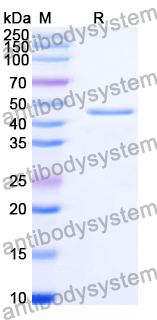Catalog No.
YHC91201
Expression system
E. coli
Species
Homo sapiens (Human)
Protein length
Met10-Arg390
Predicted molecular weight
45.52 kDa
Nature
Recombinant
Endotoxin level
Please contact with the lab for this information.
Purity
>90% as determined by SDS-PAGE.
Accession
P11940
Applications
ELISA, Immunogen, SDS-PAGE, WB, Bioactivity testing in progress
Form
Lyophilized
Storage buffer
Lyophilized from a solution in PBS pH 7.4, 0.02% NLS, 1mM EDTA, 4% Trehalose, 1% Mannitol.
Reconstitution
Reconstitute in sterile water for a stock solution. A copy of datasheet will be provided with the products, please refer to it for details.
Shipping
In general, proteins are provided as lyophilized powder/frozen liquid. They are shipped out with dry ice/blue ice unless customers require otherwise.
Stability and Storage
Use a manual defrost freezer and avoid repeated freeze thaw cycles. Store at 2 to 8°C for frequent use. Store at -20 to -80°C for twelve months from the date of receipt.
Alternative Names
PABP-1, PAB1, PABPC2, PABPC1, Polyadenylate-binding protein 1, Poly(A)-binding protein 1, PABP1
Pathogenic mutations disrupt stress granules assembly in patients with DDX3X neurodevelopmental disorder., PMID:40418049
Bioinformatics analysis reveals shared molecular pathways for relationship between ulcerative colitis and primary sclerosing cholangitis., PMID:40375266
EV-D68 cleaves LARP1 and PABPC1 by 3Cpro to redirect host mRNA translation machinery toward its genomic RNA., PMID:40294010
Mice lacking two testis-specific cytoplasmic poly(A)-binding proteins, PABPC2 and PABPC6, exhibit normal spermatogenesis and fertility., PMID:40254460
ATXN2L primarily interacts with NUFIP2, the absence of ATXN2L results in NUFIP2 depletion, and the ATXN2-polyQ expansion triggers NUFIP2 accumulation., PMID:40220918
ARC/ARG3.1 binds the nuclear polyadenylate-binding protein RRM and regulates neuronal activity-dependent formation of nuclear speckles., PMID:40208793
Deep Mutational Scanning of an Engineered High-affinity Ligand of the poly(A) Binding Protein MLLE Domain., PMID:40180125
Systemic Identification of Functionally Conserved Long Noncoding RNA Metabolic Regulators in Human and Mouse Livers., PMID:40127783
Selective translational control by PABPC1 phase separation regulates blast crisis and therapy resistance in chronic myeloid leukaemia., PMID:40102686
Coronavirus endoribonuclease nsp15 suppresses host protein synthesis and evades PKR-eIF2α-mediated translation shutoff to ensure viral protein synthesis., PMID:40096172
Yeast poly(A)-binding protein (Pab1) controls translation initiation in vivo primarily by blocking mRNA decapping and decay., PMID:40071937
Structural mechanism of LINE-1 target-primed reverse transcription., PMID:40048554
Histone acetylation activated-IGF2BP3 regulates cyclin D1 mRNA stability to drive cell cycle transition and tumor progression of hepatocellular carcinoma., PMID:40037458
circFOXK2 Stabilizes STMN1 mRNA via PABPC1 to Promote the Progression of NSCLC., PMID:40013670
EIF4E-mediated biogenesis of circPHF14 promotes the growth and metastasis of pancreatic ductal adenocarcinoma via Wnt/β-catenin pathway., PMID:40001070
Inhibition of GRK2 reduced doxorubicin-induced oxidative stress and apoptosis through upregulating ADH1., PMID:39914624
IGF2BP1 stabilizes Akt2 mRNA to promote glucose metabolism and maintain spermatogonial proliferation., PMID:39902819
Molecular Subtype Identification and Potential Drug Prediction Based on Anoikis-Related Genes Expression in Keratoconus., PMID:39898909
Antagonistic roles by the conserved nuclear poly(A)-binding proteins PABPN1 and ZC3H14 in nuclear RNA surveillance., PMID:39898550
Multi-Omics Analysis for Identifying Cell-Type-Specific Druggable Targets in Alzheimer's Disease., PMID:39830273
Higher Intron Retention Levels in Female Alzheimer's Brains May Be Linked to Disease Prevalence., PMID:39804791
Histopathologic Marks of Tongue in a Mouse Model of Oculopharyngeal Muscular Dystrophy Suggest Biomechanical Defects., PMID:39800052
PABPC1 Silencing Inhibits Gastric Cancer Cell Proliferation, Metastasis, and EMT Via the PI3K/AKT Pathway., PMID:39729165
3-Acetyldeoxynivalenol induces pyroptosis in leydig cells via METTL3-mediated N6-methyladenosine modification of NLRP3., PMID:39701865
CARF regulates the alternative splicing and piwi/piRNA complexes during mouse spermatogenesis through PABPC1., PMID:39696987
Japanese encephalitis virus NS3 captures the protein translation element by interacting with HNRNPH1 to promote viral replication., PMID:39694377
YTHDF2 promotes ATP synthesis and immune evasion in B cell malignancies., PMID:39694037
Mechanism of cold exposure delaying wound healing in mice., PMID:39568002
LINC00882, transcriptionally activated by CEBP-β and post-transcriptionally stabilized by METTL14-mediated m6A modification, exerts tumorigenesis by promoting PABPC1-mediated stabilization of ELK3 mRNA., PMID:39551868
Deciphering the RNA-binding protein network during endosomal mRNA transport., PMID:39499630
Germline DNA Damage Repair Gene Alterations in Patients with Metachronous Breast and Colorectal Cancer., PMID:39408606
Systemic identification of functionally conserved lncRNA metabolic regulators in human and mouse livers., PMID:39372743
Full-length nanopore sequencing of circular RNA landscape in peripheral blood cells following sequential BNT162b2 mRNA vaccination., PMID:39343185
Role of Poly(A)-Binding Protein Cytoplasmic 1, a tRNA-Derived RNA Fragment-Bound Protein, in Respiratory Syncytial Virus Infection., PMID:39338982
LINC01197 inhibits influenza A virus replication by serving as a PABPC1 decoy., PMID:39334466
ALK-positive large B-cell lymphoma: a clinicopathological and molecular characteristics analysis of seven cases., PMID:39237383
Pleiotropic effects of PAB1 deletion: Extensive changes in the yeast proteome, transcriptome, and translatome., PMID:39236083
Cellular RNA-binding proteins LARP4 and PABPC1 synergistically facilitate viral translation of coronavirus PEDV., PMID:39182469
Overexpression of cytoplasmic poly(A)-binding protein 1 as a biomarker for the prognosis and selection of postoperative regimen in breast cancer., PMID:39172332
Computational identification of novel potential genetic pathogenesis and otherwise biomarkers in acute liver allograft rejection., PMID:39170115
MYO5B and the Polygenic Landscape of Very Early-Onset Inflammatory Bowel Disease in an Ethnically Diverse Population., PMID:39096520
Inhibition of K63 ubiquitination by G-Protein pathway suppressor 2 (GPS2) regulates mitochondria-associated translation., PMID:39094987
CCDC189 depletion leads to oligo-astheno-teratozoospermia and male infertility in mice†., PMID:39018224
Transcriptomic and proteomic profiling of bi-partite and tri-partite murine iPSC-derived neurospheroids under steady-state and inflammatory condition., PMID:39002812
Identification of differentially expressed genes of blood leukocytes for Schizophrenia., PMID:38988837
KLHL21 suppresses gastric tumourigenesis via maintaining STAT3 signalling equilibrium in stomach homoeostasis., PMID:38969490
Phosphorylation of the nuclear poly(A) binding protein (PABPN1) during mitosis protects mRNA from hyperadenylation and maintains transcriptome dynamics., PMID:38943343
Helicobacter Pylori-Enhanced hnRNPA2B1 Coordinates with PABPC1 to Promote Non-m6A Translation and Gastric Cancer Progression., PMID:38887155
YBX1 promotes homologous recombination and resistance to platinum-induced stress in ovarian cancer by recognizing m5C modification., PMID:38880223
Concerted action of ataxin-2 and PABPC1-bound mRNA poly(A) tail in the formation of stress granules., PMID:38869059

